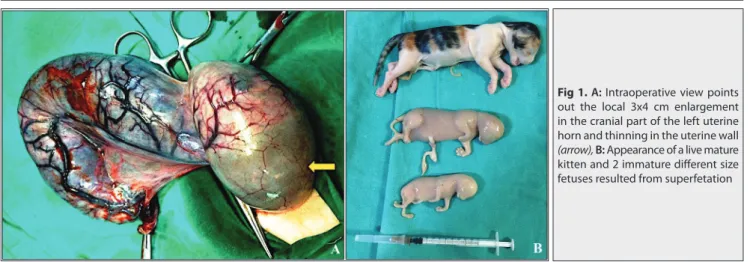Dystocia Caused by Spinal Paraplegia in a Cat with Superfetation
(Süperfetasyonlu Bir Kedide Spinal Paraplejinin Neden Olduğu Distoşya)
Emsal Sinem ÖZDEMİR SALCI
1,a Barış GÜNER
2,bVolkan İPEK
3,c1 Department of Obstetrics and Gynecology, Faculty of Veterinary Medicine, Bursa Uludag University, 16059 - Bursa - TURKEY 2 Department of Obstetrics and Gynecology, Faculty of Veterinary Medicine, Balıkesir University, 10145 - Balıkesir - TURKEY 3 Department Pathology, Faculty of Veterinary Medicine, Burdur Mehmet Akif Ersoy University, 15030 - Burdur - TURKEY ORCIDs: a 0000-0003-0154-9938; b 0000-0001-6414-6752; c 0000-0001-5874-7797
Article Code: KVFD-2020-24689 Published Online: 20.08.2020 How to Cite This Article
Özdemir Salci ES, Güner B, İpek V: Dystocia caused by spinal paraplegia in a cat with superfetation. Kafkas Univ Vet Fak Derg, 26 (6): 839-840, 2020.
DOI: 10.9775/kvfd.2020.24689
Dear Editor,
Dystocia is commonly encountered gynecological problem in veterinary medicine. The cause of dystocia is usually maternally fractured pelvis, inadequate uterine contractions, etc.; fetally it is caused by oversized fetus, fetal mal-presentation, malformations and deaths [1]. Although
superfetation is generally not common, it describes the mating and fertilization if a pregnant female shows an estrus again [1,2]. En-block overiohystectomy is a safe and effective alternative technique that allows cesarean and sterilization in cats and dogs with dystocia [1]. As reported in humans, the spinal paraplegia may lead to in the motor activity of abdominal muscles and in the autonomic nervous system, which prevents the normal birth process [3]. In this presented case, it has been emphasized that dystocia due to spinal paraplegia can be observed in cats, and superfetation is possible in paralyzed cats mated at different times.
A mix breed, 4-year-old pregnant cat with spinal paralysis was brought to our clinic with the complaint that the birth started but the cat could not give birth. In the anamnesis, it was reported that the cat was paralyzed in the thoraco-lumbar spinal region due to a traffic accident about 2.5 years ago, the cat spontaneously delivered once before paralysis, and the kitten born at that time were normal. It was reported that the cat lived with different male cats at home, was not sterilized by the idea that it could not be mating because it was paralyzed, but pregnancy was diagnosed with an ultrasound examination performed by a veterinarian as a result of abdominal enlargement. In the clinical examination, the vital parameters of the cat were determined to be normal and in the ultrasonographic
examination, 1 live kitten was found. Apart from the live kitten, 2 other kittens, smaller in size but not beating the heart, were identified. Due to the paralysis of the cat and the occurrence of dystocia, the patient owner asked for the live kitten to be removed and the cat spayed.
For premedication and induction, xylazine HCl (1 mg/ kg, im) and ketamine HCl (10 mg/kg, im) was applied respectively. Vascular cannulation was achieved with 24 no angiocath and 0.9% isotonic NaCl was infused. General anesthesia and maintenance were provided with 2% isoflurane.
After surgical preparation and antisepsis of the ventral abdominal region, the caudal abdominal area was limited to sterile covers. The abdominal cavity was reached with a median postumbilical laparotomy incision. Right and left uterine horn differed in diameter, there was local 3x4 cm enlargement in the cranial part of the left uterine horn and thinning in the uterine wall (Fig. 1-A). Routine en-bloc ovariohysterectomy operation was performed. In the right uterine horn, which was taken out explicitly, 1 live mature kitten and 2 immature different size fetuses were observed in the left uterine corn, which was determined as superfetation (Fig. 1-B). Abdominal incision was routinely closed. The two immature puppies are 5 and 7 cm in size, and were thought to be at the age of 4 and 6 weeks, respectively. While no abnormality was observed in the examination of the large immature fetus, arthrogryposis was detected in the hind limbs of the smallest fetus. There was no abnormality of the internal organs in the necropsy of these fetuses. Postoperative cefazolin Na (20 mg/kg, im., bid) and tolfenamic acid (4 mg/kg, oral, qd) were recommended for 5 days. In the 1st week and after the
other controls, the newborn kitten was reported to have
Correspondence
+90 224 2940828 GSM: +90 531 3651173 Fax: +90 224 294 08 78
ssalci@uludag.edu.trKafkas Univ Vet Fak Derg 26 (6): 839-840, 2020
DOI: 10.9775/kvfd.2020.24689
Kafkas Universitesi Veteriner Fakultesi Dergisi ISSN: 1300-6045 e-ISSN: 1309-2251 Journal Home-Page: http://vetdergikafkas.org Online Submission: http://submit.vetdergikafkas.org
840
Dystocia Caused by Spinal Paraplegia ...
survived and the paralyzed cat was in good condition. Female cats with spinal paralysis are also sexually active and it is even possible to encounter mating and pregnancies with superfetation. Autonomic dysfunction and motor nerve damage caused by spinal paralysis in cats causes dystocia by creating impaired activity in organs and muscles that help birth. For this reason, ovariohysterectomy may be recommended by veterinary clinical practitioner to owners have female cat with spinal paraplegia.
REFERENCES
1. Noakes D, Parkinson T, England G: Veterinary Reproduction and
Obstetrics. 10th ed., 109, 122, 332, Saunders, China, 2019.
2. Mcnamara HC, Kane SC, Craig JM, Short RV, Umstad MP: A
review of the mechanisms and evidence for typical and atypical twinning. Am J Obstet Gynecol, 214 (2): 172-191, 2016. DOI: 10.1016/j. ajog.2015.10.930
3. Rossier AB, Ruffieux M, Ziegler WH: Pregnancy and labour in
high traumatic spinal cord lesions. Spinal Cord, 7, 210-216, 1969. DOI: 10.1038/sc.1969.35
Fig 1. A: Intraoperative view points
out the local 3x4 cm enlargement in the cranial part of the left uterine horn and thinning in the uterine wall
(arrow), B: Appearance of a live mature
kitten and 2 immature diff erent size fetuses resulted from superfetation
